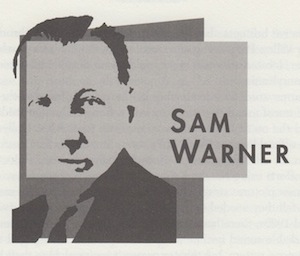
Born: July 23, 1888, Baltimore, MD
Died: October 5, 1927, Los Angeles, CA
Adding sound to movies would be like putting lipstick on the Venus de Milo.
—Mary Pickford
The first talking movie was a short test film prepared in 1889 by W.K. Laurie Dickson for demonstrating to Thomas Edison the idea of synchronized sound. Essentially, the sound system featured crude voices recorded on a disk, sort of a gramophone hooked up to a Kinetoscope. The “story” featured assistant Fred Ott saying hello to the inventor. Unfortunately, sound capabilities were extremely costly to distribute in Kinetoscope systems nationally and so they were sold with silent moving images only. The Edison labs continued with sound film experiments throughout the early days of film, but Edison eventually abandoned sound movies after a fire in his lab destroyed much of the research in 1914. Furthermore, a growing number of movie theaters were being built without sound systems of any kind. The future of sound movies seemed grim, but the determination of Sam Warner would shepherd the first genuine talking picture to the screen and quickly secure the future of talkies.
Sam Warner and his three brothers owned a bicycle shop in their hometown of Youngstown, Ohio. Like many others at the turn of the century, they saw motion pictures and became obsessed. In 1903, on the advice of brother Sam, they bought a projector, rented a copy of Edwin S. Porter’s The Great Train Robbery, traveled to the surrounding mill towns and moved smoothly into a lucrative business showing moving pictures on tours throughout the Ohio River Valley. Progressing into distribution, the Warners purchased their first theater, located in a two-story building on South Mill Street in New Castle, Pennsylvania.
Sam Warner soon took leadership as the guiding force of the Warners’ future. He transformed the company into a film production studio in 1913 and moved the outfit to California in 1917; six years later, Hollywood welcomed the official Warner Brothers Pictures, Inc. Under Sam’s care, Warners was known for its tightly budgeted, technically advanced films, including landmark efforts using Natalie Kalmus’s Technicolor process.
But Warner pictures struggled in an increasingly competitive marketplace. What Sam felt they needed to leap ahead of the pack was movies with sound. By the mid-1920s, there had already been a number of experiments to produce a workable sound system. The best of the bunch belonged to William Fox’s Movietone system, but theater owners were scratching their heads over it because there were problems with amplification and proper synchronization. Many theaters decided against incurring the expense. After all, they were making good profits with silent features; a sound film had yet to prove worthy of the headaches.
One by one, movie studios ditched their plans for the production of sound films, and it looked as though silent movies would prevail forever. Director D.W. Griffith claimed, “When the century has passed, all thought of our so-called talking pictures will have been abandoned.” Bucking the trend, Sam Warner persuaded his brothers to invest in a patented device called the Vitaphone. It was an imperfect system, recording music and voices on a coated disc, but it reproduced sound faithfully and synchronized well with on-screen images. To persuade exhibitors of the benefits of the Vitaphone, Sam sent his brothers around the country with a sampling of sound shorts, including the twelve-minute Don Juan (1926) starring John Barrymore. The first film with complete synchronization of a musical soundtrack, it also featured some sound effects. However, theater owners were still reluctant; they saw the shorts as novelty films, and what they wanted was a feature-length hit.
The Warners could hardly afford a failure; they were near bankruptcy already. On the other hand, that meant they didn’t have anything to lose, either. Sam knew William Fox was still working on the Movietone sound system, and if Fox installed new equipment in exchange for exclusive contracts with key distributors, it would mean certain death for Warner films. So Sam ran out and purchased the rights to The Jazz Singer, a Broadway play based on Sampson Raphaelson’s 1922 short story “The Day of Atonement,” and tried to lure George Jessel into playing the lead. Jessel, however, demanded too much money, so Sam went to entertainer Al Jolson and told him Jessel wanted the part. Jolson jumped at it.
Though confident the sparkling Jolson would carry the first talkie, Sam would never see the premiere. Just twenty-four hours before The Jazz Singer (1927) launched a new era in motion pictures, Sam Warner died of a cerebral hemorrhage. His brothers, all rushing from the film premier to be at his side, also missed one of the most historic moments of the twentieth century.
Warner Bros.’ Jazz Singer was a sensation. Jolson sang several songs and ad-libbed many of the short dialogue sequences. By the time he muttered the immortal line “You ain’t heard nothing yet!” audiences were cheering loudly. Lines outside theaters were consistently long for months. The incredible curiosity over The Jazz Singer, owing much to the fact that it was the screen debut of one of the year’s most talked-about entertainers, convinced theater owners of the merits of sound. The enormous receipts saved the studio from financial ruin and made it invincible. Warner Bros. became the leader in full-length all-talking color films, producing a hundred pictures a year by 1930 and controlling eight hundred theaters worldwide.
Sam Warner’s unflagging commitment to The Jazz Singer guaranteed the future of sound, but it didn’t secure the adoption of the Vitaphone. By 1930, the awkward system of sound-on-disc had been almost entirely supplanted by a host of sound-on-film processes. Nevertheless, Sam Warner’s big gamble had paid off. At the first Academy Awards presentation, on May 16, 1929, a special Oscar was presented to Warner Bros. for producing the pioneering talking picture that revolutionized the industry.
To read all the republished articles from ‘The Film 100,’ go to Reintroducing the Film 100 here on Keyframe.




